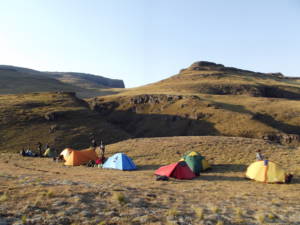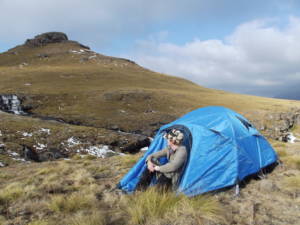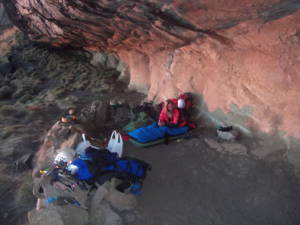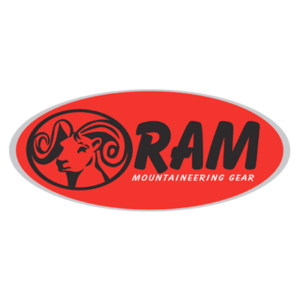Boots are perhaps the most vital piece of equipment for spending time in the mountains. They should be comfortable, durable and waterproof if going on extended multi-day hikes. If doing a shorter trip or a day hike, it may be more comfortable to use a lighter nylon boot or even a hiking shoe.
Design
Boots today are either made of leather or nylon or a combination of both types of material. Some more expensive models have Gortex incorporated into the uppers, making them fully waterproof. It is best to use full leather boots with a high ankle guard if doing long mountain walks, especially at high altitude.
Full leather boots must be made of thick cowhide leather with double stitched seams on good rubber soles, such as made by Vibram. How the upper is joined to the sole, (called welting) comes in two distinct forms. The traditional way is by the upper being double stitched, flat onto the last and the sole is then glued on underneath. In addition it may also be nailed or screwed on to add strength. This traditional method works well, but does suffer from water working its way through the stitching when wet conditions are experienced for a long time. The newer way of upper to sole attachment, is by using a rubber band around the edge of the boot, which then holds all the components together as one. This is both highly durable and more water resistant than traditional welting, but does not allow the foot to breathe so easily. Leather boots are also more water resistant and stronger when the upper is made from a single piece of leather. This design has fewer or no seams exposed on the upper, making it a high quality design and far more durable than boots made up of many pieces of leather.
The tongue of a leather boot should be sewn all the way to the top of the ankle guard area. Full leather boots are usually quite stiff and hard when new. It is therefore best to walk them in over several kilometres prior to using them in the mountains.
Features of a good leather boot
Vibram or similar soles
Single piece of leather for the uppers
Rubber randing
Good ankle support
Gortex lined
A more traditional looking boot without the waterproof rubber randing.
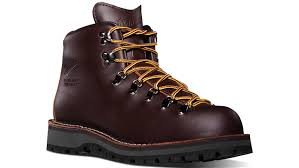
Nylon boots and shoes are often more comfortable than full leather and they seldom need to be walked in prior to proper use. Due to all the stitching used in these boots, they are never fully waterproof even when Gortex has been used in their construction, however, they are often sold as being fully “waterproof”. Hiking shoes are very good when doing easy low level hikes and where most of the walking will be on good paths. Shoes do not give good ankle support and so should be avoided if a heavy backpack is to be carried. If snow or prolonged rain could be encountered on the walk or if heavy backpacks are to be carried over rough ground, then full leather boots should be worn by the whole party. Ankle or full snow gaiters can also improve water resistance of boots.
All types of footwear should be washed after each trip. In the case of all nylon boots, ordinary soap can be used in combination with warm water and a scrubbing brush. If there is Gortex in the upper of either nylon or leather boots then follow the manufacturers care instructions. In the case of full leather boots, wash off any excess mud and grit. Then wash the leather with saddle soap or ordinary house hold soap. Rinse and then dry in a warm, dry area. When the leather is dry, treat it with a modern type leather care product such as one of the leather care Nikwax products. Again, if there is Gortex in the upper, follow the manufacturer’s instructions.

